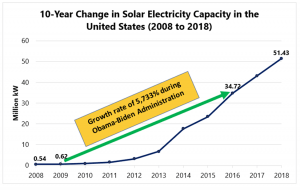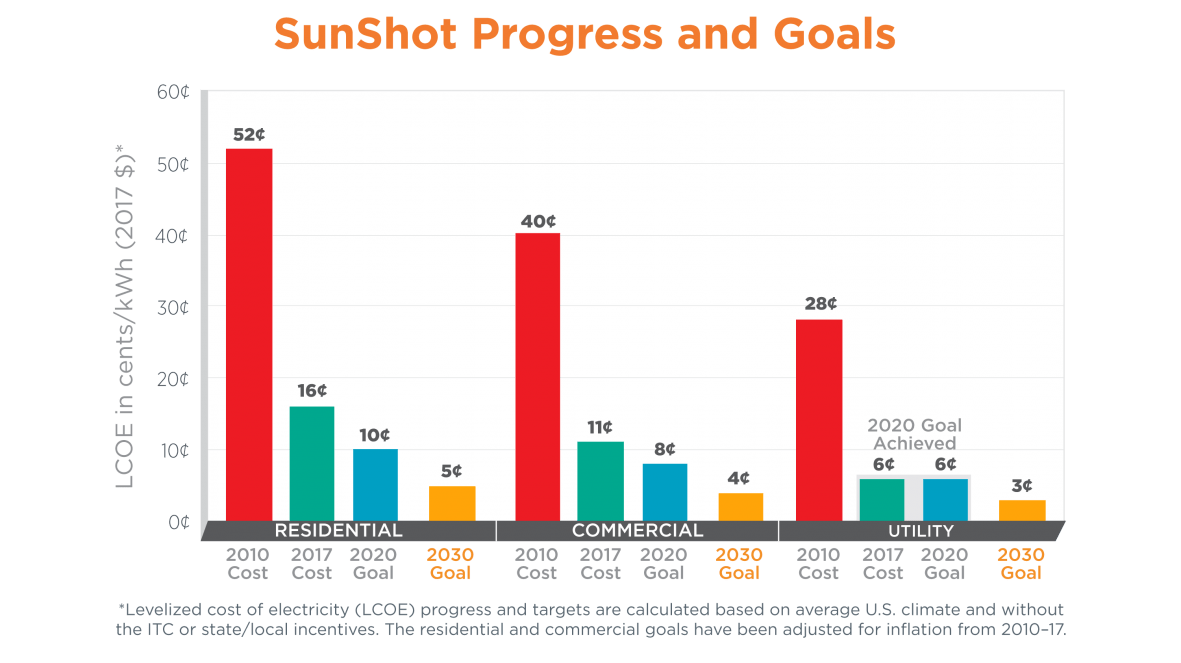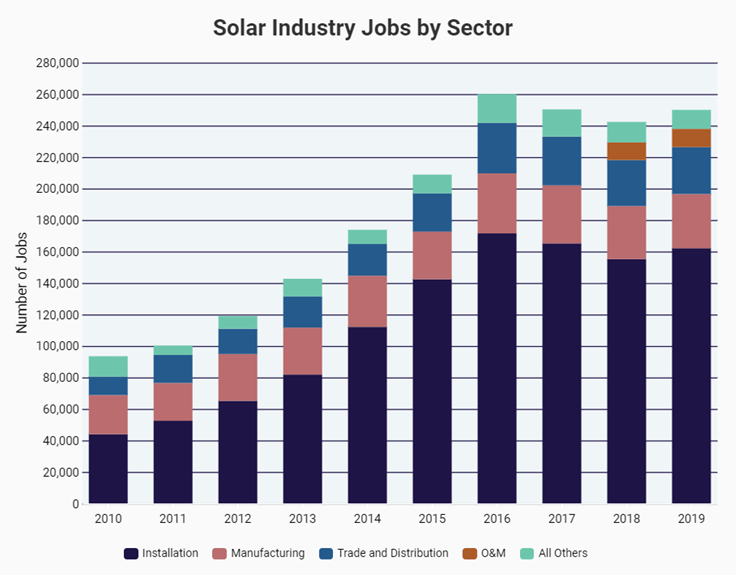With the political conventions behind us, the 2020 presidential race now starts in earnest. And while the COVID-19 outbreak and resulting economic recession are top-of-mind for most voters, it is also clear that the outcome of the election will also have a significant impact on the U.S. solar industry.
Two Known Entities
For renewable energy voters one thing is for certain – you know exactly what you’re getting with both presidential candidates. The incumbent, President Donald Trump, has a 4-year record to run on and to defend. His record when it comes to renewable energy policy is, frankly, abysmal, but we’ll get into that later.
His opponent, Joe Biden, has long served in elected office and is likewise not a mystery to pro-renewables voters. The Obama-Biden Administration presided over what was unquestionably the most prosperous era for renewable energy in American history. According to the Energy Information Administration (EIA), the U.S. had 0.62 million kW of installed solar electricity capacity in 2009 when Obama and Biden took office. That number sky-rocketed to 35 million kW by the time they left office in 2016, representing a staggering growth rate of 5,733%.

Source: Graphic generated by Solar Tribune using data from the Energy Information Administration (EIA)
The rapid growth of renewable energy capacity during the Obama-Biden Administration was due largely to the abundance of pro-renewables policies the Administration pushed.
It was Biden who was tasked with overseeing the implementation of the $787 billion American Recovery and Reinvestment Act (ARRA), which dedicated nearly $90 billion alone to renewable energy priorities, representing at the time the largest federal investment in clean energy in U.S. history. The Administration also put significant public support behind a host of other pro-renewables initiatives including the $4 billion Clean Energy Investment Initiative, which encouraged investment in promising renewable energy technologies. A lengthy list of other pro-renewables accomplishments that the Obama-Biden Administration achieved can be found here: Climate and Energy Record.
Thanks to the array of pro-renewables initiatives the Obama-Biden Administration pursued while in office and the public monies put towards solar and wind energy technologies, the costs associated with solar and wind energy production were drastically reduced. This is a dynamic that we have highlighted before at Solar Tribune. The Department of Energy launched the SunShot initiative in 2011 with the sole purpose of reducing the total costs of solar energy by 75 percent by 2020. The DOE achieved over 90% of the cost reductions towards the 2020 goal by 2016, causing them to launch a new, more ambitious goal for 2030.
In short, Joe Biden can lay claim to being in the White House during an era that saw the most rapid growth in solar capacity on record and the sharpest decline in solar costs. It is hard to imagine where the industry would be if not for the forward-thinking, pro-renewables policies that the Obama-Biden Administration prioritized over a decade ago.
Trump Ignores Solar’s Progress, Potential
To say that the Obama-Biden and Trump-Pence Administrations embraced different philosophies when it came to growing America’s clean energy sectors would be quite the understatement. President Trump has taken an adversarial position on all things renewable energy since Day 1. Strangely, his anti-renewables stance seems primarily born out of an infatuation with being “pro-coal,” given the strong electoral support he enjoys from coal miners and related constituencies in Appalachian states.
The myriad of executive roadblocks the Trump Administration has thrown at the solar industry have been covered in some detail previously at Solar Tribune. This article offers a good primer on the policies that the Administration has pursued to undermine the solar industry over the past 4 years. Since the publication of that article 8 months ago, Trump signed on to a budget deal that failed to extend the solar investment tax credit (ITC) – a key incentive in drawing residential solar users to the market. The ITC is now set to expire entirely for homeowners by 2022.
Even with all of, the solar industry has still grown rapidly during Trump’s first term. The solar industry is more mature and diversified than it has ever been, proving to skeptics that, yes, the industry can thrive on its own merits without significant inducements from the federal government. In 2019, solar accounted for over 40% of all new electric generating capacity in the U.S. at 13.3 in total installed GW. This represents the industry’s highest share ever. The residential solar sector itself brought on a record-setting 2.8 GW of installed capacity in 2019. The solar industry as a whole grew by 23% from 2018 to 2019 according to the SEIA’s Year-In-Review report, a somewhat miraculous accomplishment given the tariffs and related uncertainty the industry dealt with throughout the year.
President Trump’s efforts to stunt the promising growth of the U.S. solar industry has always been peculiar given his penchant for taking credit for the nation’s economic successes. In fact, solar jobs in the United States were growing at a rapid clip UNTIL President Trump came into office and injected a high degree of job-jeopardizing turmoil into the industry.
But again, he views the electoral politics of coal vs. solar as a zero-sum game, and he clearly has no interest in pivoting from his full-on embrace of the coal industry even if there is no rational economic basis for doing so. Note that the solar industry employed 249,983 people in 2019, according to the above SEIA graphic. For comparison, the total number of people employed in coal mining jobs hovered around 50,000 throughout 2019, with that figure falling even further in 2020 amidst COVID-19 impacts.
Unsurprisingly, there is no mention of solar energy accomplishments or renewable energy campaign policies on the Trump campaign website.
Biden’s Vision
The difference in the level of commitment in growing the nation’s clean energy economy between President Trump and Joe Biden couldn’t be starker.
Joe Biden has outlined a vision for renewable energy policy – both economic and environmental – that is arguably even more audacious than what was pursued during the first 8 years he spent in the White House.
Earlier in the summer, Biden released a climate plan that closely resembles the plan released by former candidate and climate champion Jay Inslee, governor of Washington. Biden’s plan calls for investing $2 trillion over 4 years in clean energy in an effort to make meaningful progress in stunting the effects of climate change. This massive proposed level of investment is about 2,000 times higher than the $90 billion the Obama-Biden Administration set aside for clean energy investments in the American Recovery and Reinvestment Act (ARRA) in 2009.
The staggering scale of the commitment shows that Biden understands the challenge ahead. Biden’s plan is significantly more ambitious than the plan he unveiled during the early stages of the Democratic primary which called for $1.7 trillion in spending over a longer 10-year time period. Biden understands the urgency of the moment when it comes to growing the clean energy economy and tackling climate change.
In his remarks delivered back in July on the day of the plan’s unveiling, Biden stated:
“We’re not just going to tinker around the edges. We’re going to make historic investments that will seize the opportunity and meet this moment in history.”
Biden’s plan also calls for achieving 100% clean electricity nationwide, moving his initial target date set in the Democratic primary up from 2050 to 2035. Achieving such a goal would likely require the installation of hundreds of millions of solar panels nationwide. The Biden-Sanders Unity Task Force – established to bridge differences between the progressive and moderate wings of the Democratic Party – called just for that in their set of clean energy recommendations. From page 47 of their report:
“Dramatically expand solar and wind energy deployment through community-based and utility-scale systems. Install 500 million solar panels, including eight million solar roofs and community solar energy systems, and 60,000 onshore and offshore wind turbines that are manufactured in America, creating millions of jobs, including hundreds of thousands of union jobs that cannot be outsourced.”
Put simply, Joe Biden has embraced a clean energy and climate change agenda on a scale this country has never seen a presidential candidate do before. The ambitious clean energy attainment goals he has laid out will be a shot in the arm for a solar industry that has suffered plenty of unnecessary setbacks over the past 4 years.
The United States of America needs to be a global leader when it comes to investing in renewable energy and addressing the most pressing challenge of our time – climate change. This year’s presidential election will soon tell us how serious we are as a nation about re-assuming that responsibility.
You can find out how to register to vote in your state here: https://vote.gov/
Cover Photo Source: Solar Magazine







